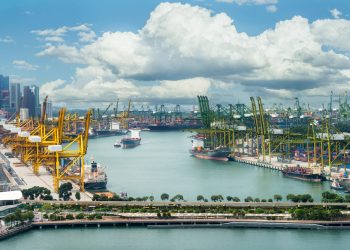Pasha Stevedoring and Terminals L.P. and the Port of Los Angeles are launching the Green Omni Terminal Demonstration Project, a full-scale, real-time demonstration of zero and near-zero emission technologies at a working marine terminal.
The Green Omni Terminal Demonstration Project at the Pasha Terminal at the Port of Los Angeles will be a solar-powered resilient facility that uses zero and near-zero emissions cargo handling equipment to move goods from ships through the terminal to clean truck and rail transportation to their final destinations. The project’s innovative technology proposed including a solar-powered microgrid, energy efficiency upgrades, zero emission cargo handling equipment and vehicles, charging infrastructure, and a dockside vessel emissions treatment system. The project seeks to help California achieve its climate change and air quality goals by reducing greenhouse gases and other harmful air emissions in the Wilmington community. The project also will demonstrate the operational and commercial viability of electrified equipment and vehicles and serve as a scalable model for sustainable and resilient goods movement that can be replicated at thousands of multi-source facilities throughout California, the nation, and the world.
Technology, Equipment and Vehicles:
- 1 Megawatt Solar Photovoltaic System
- 2.6 Megawatt-hour Battery Storage System (1 unit)
- Energy Control System
- Charging Equipment (9 units)
- Wharf Crane Drive Upgrades (2 cranes)
- ShoreCat on-dock vessel emissions capture and treatment system
- Electric Yard Tractors (4 vehicles)
- 21-Ton Electric Forklifts (2 vehicles)
- Electric Top Handler (1 vehicle)
- On-Road Drayage Trucks (2 vehicles)
 Project implementation will start in June with the final design and construction of the solar-powered microgrid. Components include a 1.03 megawatt photovoltaic rooftop array, a 2.6 megawatt-hour battery storage system, “bi-directional” charging equipment that can receive as well as supply power, and an energy management control system.
Project implementation will start in June with the final design and construction of the solar-powered microgrid. Components include a 1.03 megawatt photovoltaic rooftop array, a 2.6 megawatt-hour battery storage system, “bi-directional” charging equipment that can receive as well as supply power, and an energy management control system.
The project’s developmental fleet of zero-emission cargo handling equipment includes four electrified yard tractors, two high-tonnage forklifts, two drayage trucks and a top handler. Additionally, two wharf cranes will be upgraded with new electrical drives and control systems, and the project will demonstrate ShoreCat, the next generation of the METS-1 (Marine Exhaust Treatment System) for capturing at-berth vessel emissions without plugging into shore power. METS-1, which was piloted at the Port of Los Angeles, is one of only two existing ARB-approved alternatives to shore power.
The comprehensive strategy is expected to reduce more than 3,200 tons per year of greenhouse gases and nearly 28 tons annually of diesel particulate matter, nitrogen oxides and other harmful emissions from operations at the nation’s busiest container port. The clean air gains equate to taking 14,100 cars a day off the road in the South Coast Air Basin.In addition to integrating zero-emission vehicles and cargo handling equipment into the full scope of terminal operations, the project’s goals are to reduce emissions at berth from non-regulated ships, accelerate the development of commercially viable zero and near-zero emission equipment and solutions.
The competitive grant, the first of its kind for a multi-source facility demonstration project available through the ARB, required matching funds of at least 25 percent. Pasha, the Port and other partners exceeded that threshold with a 44 percent funding match.
A hallmark of the project is collaboration with green-tech original equipment manufacturers and technical experts from the private sector, academia and regulatory agencies. With Pasha and the Port of Los Angeles at the helm, the project’s partners are the engineering firm of Burns & McDonnell; original equipment green-tech manufacturers BYD, Clean Air Engineering Maritime, PermaCity and TransPower; the Coalition for Clean Air acting as the project’s community advisor; and technical experts from the Los Angeles Department of Water and Power, the South Coast Air Quality Management District, the UCLA Luskin Center for Innovation, and the University of California, Riverside’s College of Engineering Center for Environmental Research and Technology.
Labor is also a crucial partner. From the get-go, the project incorporates training of the International Longshore and Warehouse Union workers who will operate and repair the equipment.Project plans call for phasing in the new infrastructure and technology by the end of 2016, with zero and near-zero emission equipment subject to the same rigorous duty cycles of conventional cargo handling equipment. Data collection and analysis to track energy efficiency improvements and cost savings will take place over the subsequent two years.
The genesis for the project was the Port and Pasha’s commitment to ensuring Southern California could supply energy and basic goods to the community and serve as a base of operations for the military in the event of a natural or mandate disaster, while simultaneously meeting these critical infrastructure needs with renewably powered zero emission technologies. The commercial component followed.
“This is something we’ve put a lot of time and energy into for all the right reasons,” said Burgin, adding the project is the first phase of more innovation ahead for Pasha. “This is scratching the surface of where this industry is going to go, and we’re already planning the next phases to get us there.”
Source & Image credit:Port of Los Angeles





























































